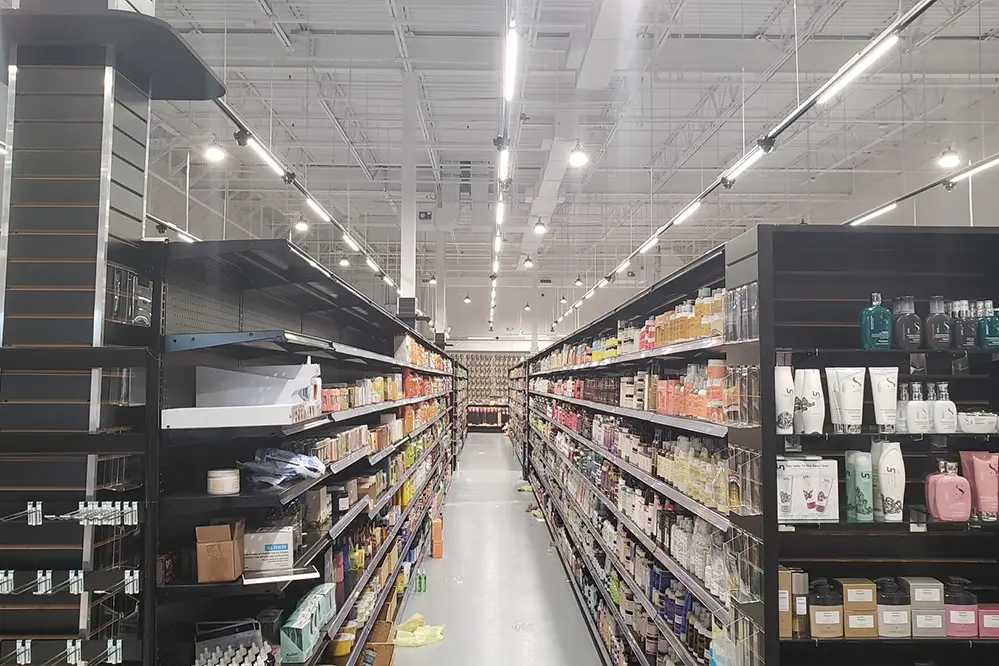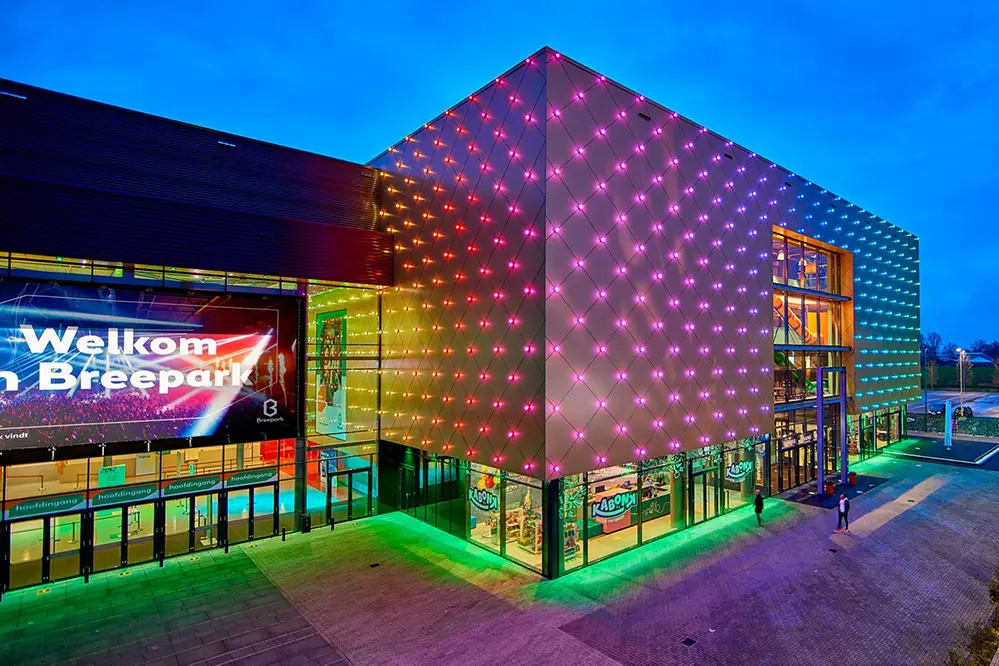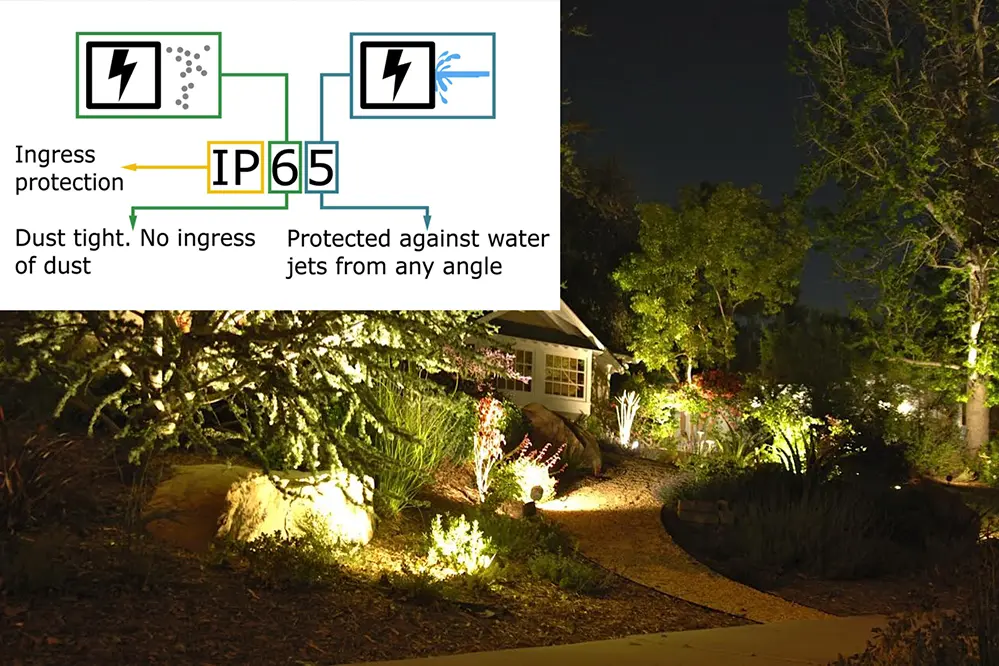“Good lighting is not just about visibility; it is about creating an environment that fosters healing and efficiency,” says Dr. Jane Thompson, a renowned expert in healthcare design. In “The Complete Hospital Lighting Ultimate Guide: Efficiency and Comfort,” we explore the pivotal role that lighting plays in healthcare settings. Hospital lighting is a powerful tool that can enhance patient recovery, improve staff performance, and reduce energy consumption, making it an indispensable element in modern healthcare facilities.
The impact of lighting extends across various aspects of life and industry, particularly in healthcare. Proper lighting can influence patient mood and recovery times, while also boosting the productivity and well-being of healthcare professionals. Moreover, energy-efficient lighting solutions contribute to environmental sustainability and cost savings, making them an essential consideration for hospitals aiming to optimize their operations and reduce their carbon footprint.
Join us as we delve into the fascinating world of hospital lighting, uncovering insights and strategies that promise to revolutionize healthcare environments. This guide is your gateway to understanding how to achieve the perfect balance of efficiency and comfort in hospital lighting. Whether you are a healthcare professional, facility manager, or simply interested in the topic, this comprehensive guide offers a wealth of information to help you illuminate the path to a brighter, more sustainable future in healthcare.
Understanding Hospital Lighting Needs
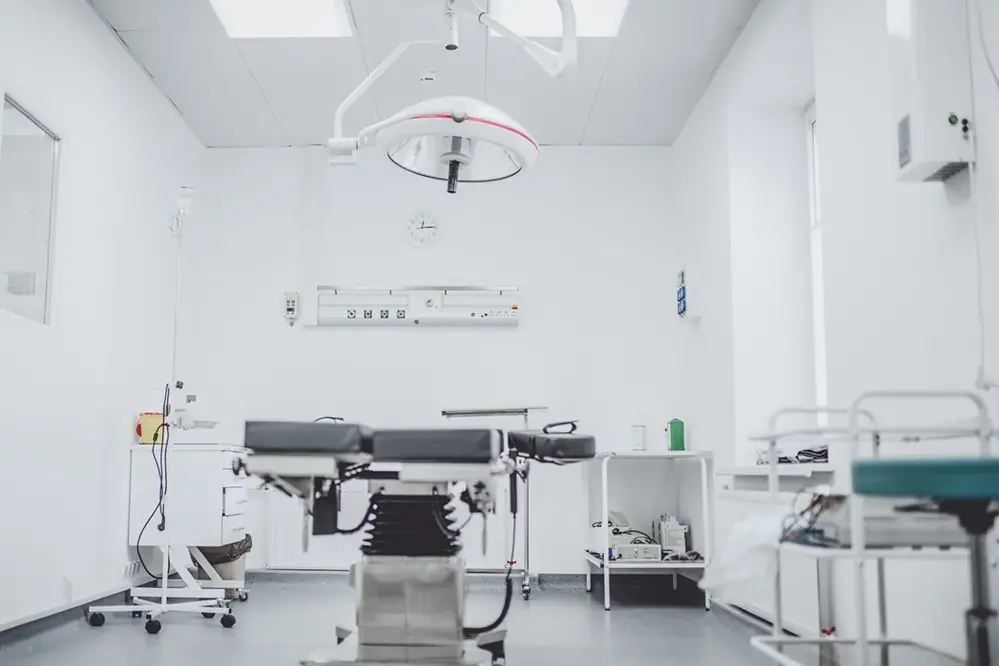
Hospital environments are dynamic spaces requiring precise lighting solutions that cater to diverse scenarios, each with its unique set of demands.
Patient rooms, surgical suites, and common areas each have different requirements.
While patient rooms benefit from lighting that promotes relaxation and healing, surgical areas demand a high level of illumination that enables precision, accuracy, and the confidence of their medical teams. These specialized settings require careful consideration of color temperature, brightness, and adaptability.
The challenge lies in designing a system that not only meets the varying needs of each area but does so in a way that optimizes energy use, considers ergonomics, and maintains unparalleled performance. By adopting advanced technologies and understanding human-centric design principles, hospitals can achieve a “light” of excellence in providing a supportive and efficient atmosphere.
Types of Hospital Lighting Solutions
Redefining illumination in healthcare settings is crucial.
First, we have general lighting, which sets the ambient tone throughout the facility. This lighting type ensures that hallways and waiting areas remain well-lit without being overwhelming, creating a welcoming and safe environment. Next is task lighting, essential for specific activities that require focused light, such as patient examinations or administrative work.
Accent lighting plays an aesthetic role.
It highlights artwork or architectural features, providing a sense of calm and beauty to otherwise clinical spaces. Meanwhile, surgical lighting solutions, tailored for operating rooms, facilitate precise procedures with exceptional clarity and minimal shadows.
Finally, tunable white lighting offers dynamic control over color temperature and intensity, adapting seamlessly to clinical needs throughout the day. This innovative technology empowers hospitals to harness the natural circadian rhythms of patients and staff, promoting alertness and overall well-being. By leveraging these diverse lighting solutions, healthcare institutions can transform their environments into places of healing and reassurance.
Benefits of Efficient Hospital Lighting
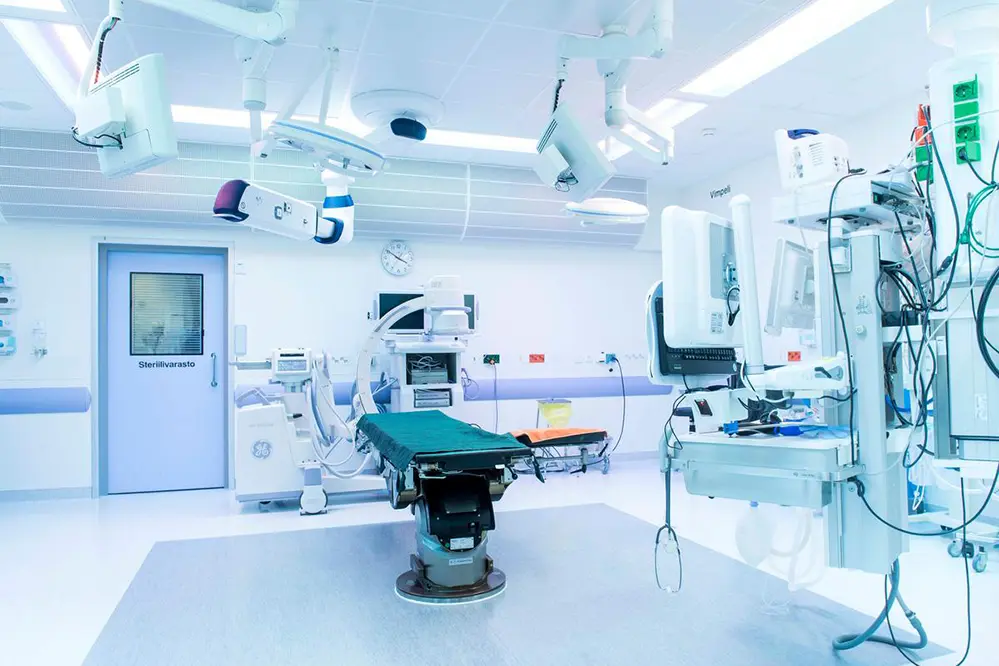
Efficient hospital lighting is an indispensable element, offering myriad benefits that extend beyond mere illumination, significantly enhancing patient experiences and healthcare providers’ operational efficiency.
Properly designed lighting systems elevate the healing process by reducing stress and anxiety in patients.
Additionally, thoughtfully planned lighting solutions improve medical staff performance and accuracy, enhancing (potentially life-saving) procedural outcomes.
These lighting systems also contribute to energy conservation by maximizing efficiency and reducing overhead costs, allowing facilities to reallocate resources effectively.
More than just providing visibility, efficient lighting designs integrate seamlessly with interior aesthetics, infusing environments with warmth and tranquility that inspire both patients and staff on their wellness journeys.
Ultimately, the application of efficient hospital lighting’s advantages lies in its ability to foster environments that support healing. Thoughtful illumination solutions pave the way for brighter, healthier futures.
Energy-Saving Lighting Technologies
Innovative energy-saving lighting technologies have revolutionized how hospitals manage their energy consumption, creating brighter, more vibrant, and cost-effective environments. LED technologies, cutting-edge sensors, and self-calibrating systems work in concert to reduce energy expenditures while unlocking the potential of sustainable operations.
These advanced technologies significantly decrease this sector’s carbon footprint, enabling hospitals to commit more resources to enhancing patient care.
LED Lighting Solutions
LED lighting solutions have transformed hospital environments into sanctuaries of healing, offering a dynamic blend of efficiency and visual comfort. These solutions harmonize functionality with aesthetic appeal, positively impacting patient recovery.
The adaptability and longevity of LED systems make them an unmatched choice for healthcare settings. Hospitals benefit from “smart lighting” that adjusts to natural light, enhancing energy efficiency and patient satisfaction.
LED lighting reduces operational costs while supporting sustainable healthcare practices, fortifying the institution’s commitment to environmental responsibility.
Furthermore, LED lights release minimal heat, which is crucial in maintaining cooler and more comfortable hospital environments. This innovative approach not only trims costs but also supports the overall well-being of both patients and healthcare providers, fostering an uplifting atmosphere conducive to recovery and care delivery.
Motion Sensor Lighting
Motion sensor lighting represents a revolutionary integration of technology and efficiency in hospital settings, enhancing both patient experience and energy savings.
- Reduced Energy Consumption: Lights activate only when needed, minimizing unnecessary energy use.
- Increased Safety: Ensures consistent illumination in critical areas, reducing the risk of accidents.
- Minimal Disruption: Patients experience fewer disturbances at night as lights only illuminate when necessary.
- Cost-effective: Over time, results in significant savings on electricity bills.
These lights adapt seamlessly to the dynamic requirements of healthcare spaces, offering enhanced flexibility and reliability. They intelligently respond to motion, ensuring that critical areas remain well-lit.
In essence, motion sensor lighting marries modern technology with practical application, ensuring hospitals remain at the forefront of innovation while prioritizing patient care and operational efficiency.
Importance of Comfort in Hospital Lighting
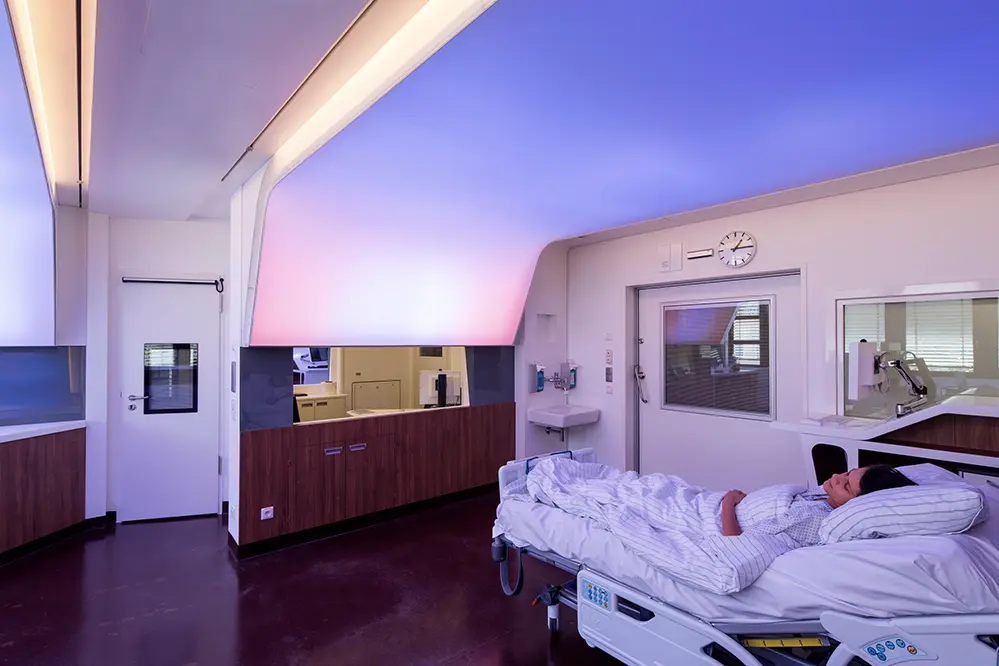
In hospital environments, comfort through lighting plays a vital role in both recovery and the overall well-being of patients and staff.
The transition from cold, clinical lighting to a warmer, adaptive lighting strategy can substantially enhance patient experiences, helping reduce stress and apprehension often associated with hospital visits. Optimal lighting conditions are not only essential for clear visibility but also for nurturing spaces that promote relaxation and healing. Such an environment fosters psychological comfort, which can lead to positive health outcomes and enhanced patient satisfaction.
Remarkably, this emphasis on a supportive ambiance also aids medical staff. By reducing eye strain and fatigue, it enhances focus and precision in their work. A welcoming lighting environment supports daytime alertness and nighttime rest, facilitating better healthcare delivery.
Through thoughtful implementation of lighting solutions that harmonize with the body’s natural rhythms, hospitals can transform into environments where patients feel more at ease, and professionals operate with greater efficacy. This evolution in lighting design is a testament to our unyielding commitment to crafting spaces that enlighten the path to improved health and well-being, reflecting hospitals’ dedication to blending comfort with cutting-edge care.
Lighting for Patient Rooms
Patient room lighting plays a pivotal role in the overall healing experience and sense of well-being, encouraging both recovery and tranquility for occupants.
The lighting solutions used must be adaptable, responding to the ever-changing needs of patient care.
Innovative designs prioritize natural light integration while incorporating adjustable fixtures that adapt to a spectrum of activities, creating an atmosphere suited for healing, restfulness, and the demands of modern medical care.
Smart technology further elevates room lighting by allowing adjustments at the touch of a button, offering personalized lighting settings that can enhance mood or aid specific treatments. From soothing hues, emulating a “sunset” effect to encourage relaxing transitions into sleep, to brighter illumination for reading or interacting, the possibilities for dynamic and responsive lighting are virtually limitless. These initiatives underscore the manifest importance of harmonizing form and function, nurturing a patient’s journey to recovery in a comforting and supportive setting.
Lighting for Operating Theaters
In the realm of healthcare, operating theaters require lighting that is both precise and reliable, facilitating effective surgical outcomes.
Such settings demand advanced lighting systems to ensure that intricate procedures can be carried out with precision. High-quality lighting minimizes shadowing and offers adjustable intensity, adapting to diverse surgical requirements. This ensures optimal visibility for medical professionals, enhancing their ability to deliver exceptional patient care. Through technological advancements, these lighting systems contribute to a safer and more efficient surgical environment.
Moreover, the lighting in operating theaters must accommodate the psychological needs of surgical teams. By incorporating ergonomic designs, it can reduce eye strain and fatigue, allowing surgeons and staff to maintain focus for extended periods. The well-being of surgical teams is, therefore, significantly supported by thoughtful lighting solutions that align with the human circadian rhythm.
Ultimately, optimal lighting systems reflect a commitment to excellence within medical facilities. As this hospital lighting ultimate guide attests, investing in sophisticated, adaptable lighting contributes not only to the immediate needs of surgical procedures but also to the long-term health and wellness of both patients and practitioners. Through such dedication, hospitals continue to pave the way for transformative healthcare, ensuring every light cast is aligned with the beacon of healing and innovation.
Lighting for Emergency Rooms
Lighting in emergency rooms is paramount, influencing both the efficiency and effectiveness of care provided in critical moments.
In recent years, numerous advancements in hospital lighting solutions revolutionized emergency room environments, emphasizing the necessity of ideal lighting conditions that foster quick decision-making and reduce errors. Proper lighting is vital for medical professionals navigating the high-pressure situations of emergency care, ensuring they have the necessary focus and clarity.
Today, it’s more important than ever for hospital lighting to be adaptable to a spectrum of needs. From the rapid assessment of trauma patients to the meticulous administration of treatment, versatile lighting systems play a crucial role in promoting clear visual perception and enhancing productivity in emergency settings.
Achieving the balance of bright, focused illumination and the ability to dim when required is the essence of a 24/7 emergency room facility. Implementing LED technology with tunable white light options, designed to adjust according to time of day and specific medical requirements, can significantly aid both healthcare providers and patients by minimizing fatigue and stress.
Effective lighting not only supports clinical tasks but also contributes to creating a calming environment, enabling patients to experience a sense of reassurance.
Lighting for Common Areas
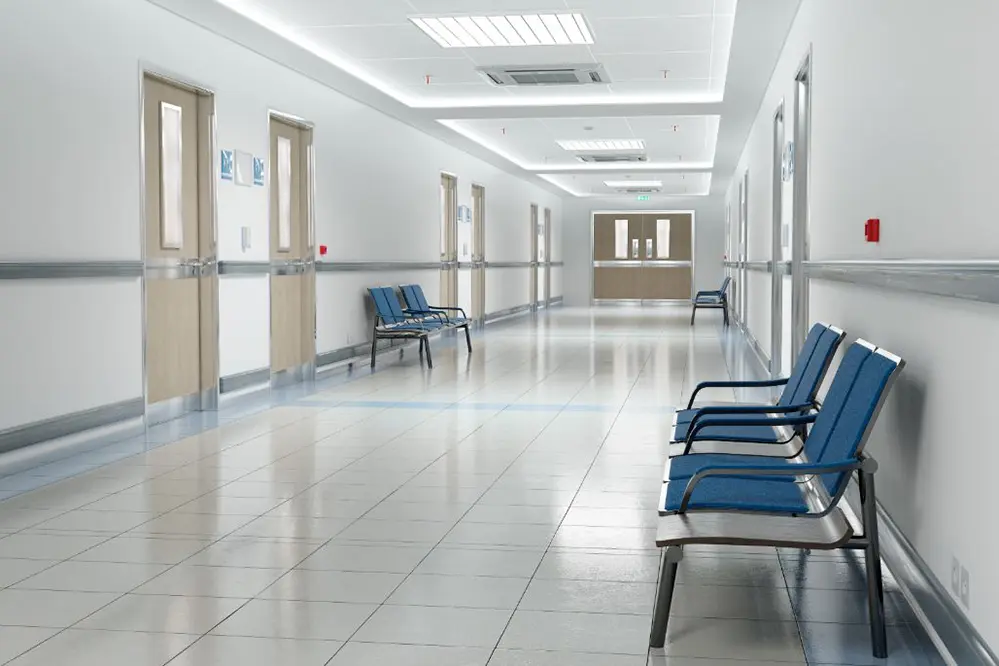
Common areas in hospitals require lighting solutions that cater to both functionality and aesthetics, enhancing the overall experience for all who enter.
Incorporating natural light, when possible, and using energy-efficient LED fixtures, these spaces can transform into inviting and pleasant environments. Such thoughtful lighting design plays a crucial role in optimizing both patient satisfaction and staff productivity.
Healthcare facilities must prioritize the comfort and well-being of their occupants, utilizing lighting strategies that reduce glare and create soft, evenly distributed illumination. This approach nurtures a positive atmosphere while remaining functional for everyday hospital activities.
Furthermore, choosing fixtures that can seamlessly adjust to different brightness levels is essential. This flexibility not only enhances visual comfort but also helps in maintaining an environment that feels welcoming and secure at any time of day.
Ultimately, well-designed lighting in common areas reinforces the hospital’s commitment to a supportive, healing-oriented environment.
Design Considerations for Hospital Lighting
Hospital lighting must cater to both functional efficiency and the emotional well-being of patients, staff, and visitors, serving as a cornerstone of the holistic care environment.
Focusing on adjustable systems enhances adaptability and effectiveness.
Transitioning spaces need focused lighting design for clear wayfinding, increasing safety and reducing stress-inducing confusion.
Natural daylight should be maximized, complementing artificial light sources when appropriate.
Sustainable principles are crucial, with energy-efficient fixtures minimizing environmental impact while maintaining quality. Prioritizing advanced control systems supports energy conservation and facility adaptability, creating a responsive setting.
Overall, the aim is to craft spaces that embody healing. Strategic lighting invigorates spaces to support healthcare excellence and foster positive experiences.
Role of Natural Light in Hospitals
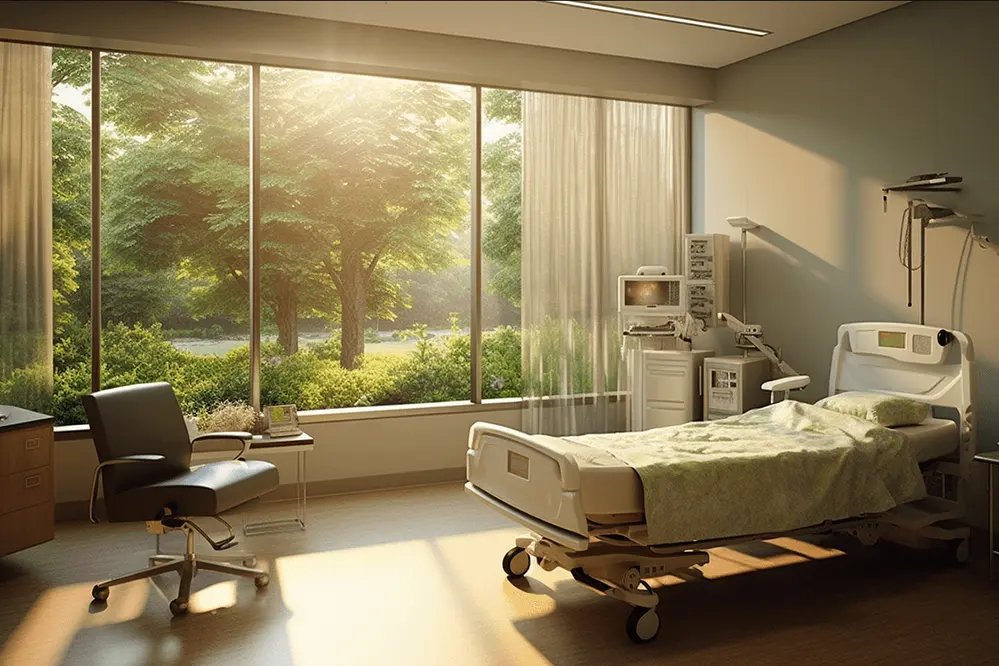
Natural light is unparalleled in its benefits.
Its integration into hospital design can profoundly impact patient well-being. The ample presence of natural light not only enhances the aesthetic appreciation of healthcare environments but also significantly contributes to the healing process. Studies consistently show that exposure to natural light accelerates recovery and reduces patient stress.
The benefits of daylight extend beyond health and emotion.
Natural light aids in regulating circadian rhythms – a critical aspect in maintaining proper sleep patterns and overall health – while also reducing reliance on artificial lighting and thereby cutting energy costs.
Incorporating natural lighting effectively requires innovative architectural designs, leveraging the latest technological advancements of the new year era to maximize its potential benefits. This ensures a seamless blend of comfort, sustainability, and superior health outcomes for everyone within the hospital environment.
Impact of Lighting on Patient Recovery
Lighting profoundly affects patient recovery.
It is well-documented that appropriate lighting can enhance healing. The right balance of light not only supports the physiological aspects of patient recovery by regulating hormones and body rhythms but also alleviates psychological discomforts encountered during hospitalization. Furthermore, improvements in lighting can lead to remarkable reductions in recovery times.
Optimal lighting transforms patients’ mood positively.
Illuminating spaces effectively – in ways that mimic natural light as closely as possible – leads to accelerated tissue regeneration and enhanced immune responses. Moreover, it nurtures a sense of peace and tranquility crucial for recuperation and well-being.
As we push forward with modern innovations in hospital lighting, we are confidently ushering in advanced, enlightening experiences that define the state-of-the-art in the new year and beyond. These lighting strategies not only cater to health improvements but lay the groundwork for inspiring, patient-centered environments across the healthcare spectrum.
Hospital Lighting Maintenance Best Practices
Effective maintenance ensures optimal hospital lighting.
Regular inspections must form the core practice. They serve not only to extend the lifespan of lighting installations but also to reduce operational expenses through early fault detection. Consistently assessing fixtures and controls helps maintain the intended balance between energy efficiency and patient comfort, securing safety and peace of mind.
The priority is preventing disruptions that impact care.
Including comprehensive training for maintenance staff – on the latest lighting technologies as well as traditional equipment – is vital for skill development and efficient problem resolution. Additionally, utilizing advanced diagnostic tools enhances quick diagnosis of lighting issues.
A predictive maintenance approach empowers healthcare facilities by leveraging emerging technologies and data analytics to anticipate potential failures. This proactive strategy ensures reliability and minimizes downtime, thus contributing to a consistently comforting and healing environment for patients throughout their care journey.
Budgeting for Hospital Lighting Projects
Embarking on a hospital lighting project, balancing budget considerations with design decisions can seem daunting but offers opportunities for creativity and innovation.
First and foremost, to craft a comprehensive budget for a hospital lighting project, one must evaluate various factors, including the scale of the project, existing infrastructure, and the complexity of the design required. Leveraging resources like financial assessments and vendor consultations can transform these initial hurdles into knowledge-based stepping stones towards successful project execution. Strategic planning, focusing on long-term value rather than up-front costs, remains pivotal for deriving optimal benefits.
Furthermore, carefully assessing the lifecycle costs of different lighting options is indispensable. By understanding power, maintenance, and replacement costs, the hospital can identify solutions that not only fit within current financial constraints but also support sustainable financial planning for the future.
Optimizing hospital lighting within budgetary limits involves innovation and strategic thinking to achieve excellence without overshooting costs. Investing in modern technologies, such as energy-efficient LED systems, and employing smart control systems can yield significant savings by reducing energy consumption and maintenance expenses. Thus, these investments, though initially substantial, bestow long-lasting financial advantages and contribute to a hospital environment that promotes wellness and patient comfort.
Regulatory Standards for Hospital Lighting
Navigating regulatory standards in hospital lighting is crucial for ensuring a safe, comfortable, and healing environment. Setting the stage for excellence, a systematic adherence to these standards fortifies both patient satisfaction and institutional reputation.
These regulations serve as the underlying framework that guides the implementation of effective lighting solutions.
Primarily, global regulatory bodies like the International Electrotechnical Commission (IEC) and regional standards illuminate pathways.
Standards dictate key factors including illumination levels, minimizing glare, and achieving energy efficiency, ensuring optimal visual conditions.
Compliance with these guidelines supports not only the practical needs but reverberates through strategic enhancements of care delivery, enhancing patient recovery and staff efficiency. By embedding these standards into the design, hospitals can create healing environments that are not just functional, but inspirational.
Ultimately, the goal is more than mere adherence; it’s the commitment to cultivating spaces where health and comfort are seamlessly intertwined. Adhering to regulatory standards is where innovation meets responsibility in this noble pursuit.
Future Trends in Hospital Lighting
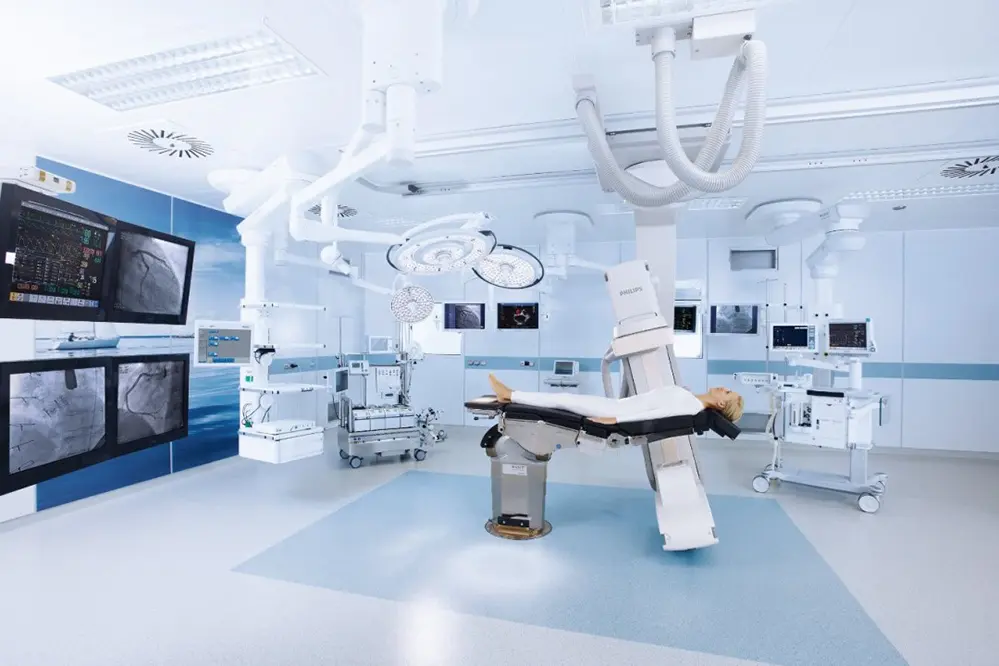
As hospital lighting evolves, remarkable innovations promise to redefine healing spaces and enhance patient experiences.
In the coming years, we can anticipate a paradigm shift toward personalized lighting systems. These systems, adaptable to individual patient needs, hold the potential to revolutionize recovery processes. By integrating circadian rhythm-based settings, hospitals will not only improve sleep quality but also boost overall patient wellness. Such technologies are already gaining traction, ushering in an era of truly patient-centered care that benefits both patients and healthcare professionals.
Simultaneously, eco-conscious designs will take precedence in hospital lighting solutions. With sustainability at the forefront, innovations like solar-powered lighting and energy-efficient LED systems enable healthcare facilities to significantly reduce their carbon footprint while maintaining optimal lighting conditions.
In conclusion, future trends in hospital lighting embody a seamless blend of personalization and sustainability. By embracing such advanced technologies, healthcare facilities can offer environments that not only facilitate healing but also foster a sense of well-being and ecological harmony, setting new benchmarks for excellence in patient care.
Choosing the Right Lighting Provider
Selecting the optimal lighting provider requires careful consideration to ensure efficiency and the highest standards of care.
Firstly, in this hospital lighting ultimate guide, prioritize providers with a proven track record, ensuring they understand unique healthcare needs and regulatory requirements. By partnering with companies that offer innovative solutions and extensive experience, healthcare facilities can achieve the perfect balance of technology and comfort needed to illuminate spaces effectively.
Moreover, seek providers that offer comprehensive consultation throughout the project. This involves discussing a facility’s specific needs, offering tailored recommendations, and providing support in making informed decisions that align functionally and aesthetically with the hospital’s architecture.
Finally, prioritize providers that are dedicated to on-going support and maintenance. Excellent providers will not only supply high-quality lighting solutions but also commit to ensuring that their systems continue to function optimally over time. This dedication enhances the sustainability and reliability of the hospital’s lighting, contributing to both patient satisfaction and operational excellence.
Conclusion
Hospital lighting transcends mere illumination; it is a vital component in enhancing patient care, safety, and staff efficiency. A meticulously designed lighting system can dynamically transform hospital spaces, creating environments that support healing and operational precision. From patient rooms to surgical theaters, effective lighting is essential in fostering a setting conducive to recovery and high-quality care.
By leveraging advanced technologies and sustainable practices, healthcare facilities can enhance their aesthetic appeal while ensuring robust functionality. LED lighting, motion sensors, and tunable white lighting are just a few examples of innovations that contribute to energy efficiency and adaptability. These solutions not only reduce the hospital’s carbon footprint but also allow for a more responsive and supportive environment, advancing healthcare excellence.
The hospital lighting ultimate guide underscores the integral role of a comprehensive and strategic approach in creating spaces that reflect the evolving world of healthcare. By prioritizing human-centric designs and embracing cutting-edge solutions, institutions can illuminate a path toward a brighter, healthier future for all stakeholders involved. This commitment to innovative lighting design ensures that hospitals remain at the forefront of providing exceptional care and comfort.

